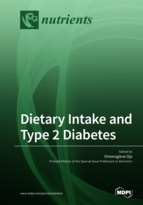Dietary Intake and Type 2 Diabetes
A special issue of Nutrients (ISSN 2072-6643).
Deadline for manuscript submissions: closed (28 February 2019) | Viewed by 173186
Special Issue Editor
Interests: nutrition; prebiotics; diabetes; glycaemic index of food; dietary fibre; gut microbiome
Special Issues, Collections and Topics in MDPI journals
Special Issue Information
Dear Colleagues,
The prevalence of diabetes is on the rise globally, and it is estimated that about 90% of adults currently diagnosed with diabetes have type 2 diabetes (National Institute for Health and Care Excellence, 2015). According to the World Health Organisation (2016), an estimated 422 million adults were living with diabetes in 2014 compared with 108 million in 1980 and this condition caused about 1.5 million deaths in 2012.
Strategies for managing type 2 diabetes often include dietary interventions. Therefore, the current Special Issue on dietary intake and type 2 diabetes aims to provide a platform for researchers to publish their research findings. It will also enable patients and others including nurses, dietitians and doctors who are involved in this area of practice to draw on the research findings for management, practice, clinical and professional development.
Dr. Omorogieva Ojo
Guest Editor
Manuscript Submission Information
Manuscripts should be submitted online at www.mdpi.com by registering and logging in to this website. Once you are registered, click here to go to the submission form. Manuscripts can be submitted until the deadline. All submissions that pass pre-check are peer-reviewed. Accepted papers will be published continuously in the journal (as soon as accepted) and will be listed together on the special issue website. Research articles, review articles as well as short communications are invited. For planned papers, a title and short abstract (about 100 words) can be sent to the Editorial Office for announcement on this website.
Submitted manuscripts should not have been published previously, nor be under consideration for publication elsewhere (except conference proceedings papers). All manuscripts are thoroughly refereed through a single-blind peer-review process. A guide for authors and other relevant information for submission of manuscripts is available on the Instructions for Authors page. Nutrients is an international peer-reviewed open access semimonthly journal published by MDPI.
Please visit the Instructions for Authors page before submitting a manuscript. The Article Processing Charge (APC) for publication in this open access journal is 2900 CHF (Swiss Francs). Submitted papers should be well formatted and use good English. Authors may use MDPI's English editing service prior to publication or during author revisions.
Keywords
- Macronutrients intake and type 2 diabetes
- Micronutrients intake and type 2 diabetes
- Oral nutritional supplements and type 2 diabetes
- Special diets including low carbohydrate diet, low fat diet, enteral nutrition, diabetes specific formulas and type 2 diabetes
- Dietary fibre intake and type 2 diabetes
- Low glycaemic index diet and type 2 diabetes







